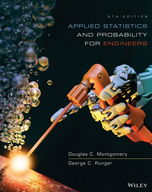Solution Found!
An article in the Journal of Database Management
Chapter 2, Problem 72E(choose chapter or problem)
An article in the Journal of Database Management ["Experimental Study of a Self-Tuning Algorithm for DBMS Buffer Pools" (2005, Vol. 16, pp. 1-20)] provided the workload used in the TPC-C OLTP (Transaction Processing Performance Council's Version C On-Line Transaction Processing) benchmark, which simulates a typical order entry application. See Table .
The frequency of each type of transaction (in the second column) can be used as the percentage of each type of transaction. The average number of selects operations required for each type of transaction is shown. Let denote the event of transactions with an average number of selects operations of 12 or fewer. Let
denote the event of transactions with an average number of updates operations of 12 or fewer. Calculate the following probabilities.
(a) \(P(A)\)
(b) \(P(B)\)
(c) \(P(A \cap B)\)
(d) \(P\left(A \cap B^{\prime}\right)\)
(e) \(P(A \cup B)\)
Equation transcription:
Text transcription:
P(A)
P(B)
P(A cap B)
P(A cap B^{\prime})
P(A cup B)
Questions & Answers
QUESTION:
An article in the Journal of Database Management ["Experimental Study of a Self-Tuning Algorithm for DBMS Buffer Pools" (2005, Vol. 16, pp. 1-20)] provided the workload used in the TPC-C OLTP (Transaction Processing Performance Council's Version C On-Line Transaction Processing) benchmark, which simulates a typical order entry application. See Table .
The frequency of each type of transaction (in the second column) can be used as the percentage of each type of transaction. The average number of selects operations required for each type of transaction is shown. Let denote the event of transactions with an average number of selects operations of 12 or fewer. Let
denote the event of transactions with an average number of updates operations of 12 or fewer. Calculate the following probabilities.
(a) \(P(A)\)
(b) \(P(B)\)
(c) \(P(A \cap B)\)
(d) \(P\left(A \cap B^{\prime}\right)\)
(e) \(P(A \cup B)\)
Equation transcription:
Text transcription:
P(A)
P(B)
P(A cap B)
P(A cap B^{\prime})
P(A cup B)
ANSWER:
Step 1 of 7
Lets, take the required data:
Transaction |
New order |
Payment |
Order Status |
Delivery |
Stock level |
Frequency |
43 |
44 |
4 |
5 |
4 |
Selects (A) |
23 |
4.2 |
11.4 |
130 |
0 |
Updates (B) |
11 |
3 |
0 |
120 |
0 |
Given,
Total number of samples = 100.
The probability of an event is determined as the ratio of the number of outcomes in the event to the number of outcomes in the sample space (for equally likely outcomes), ie;
